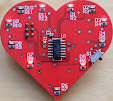Signal integrity or
SI is a set of measures of the quality of an electrical signal. In digital
electronics, a stream of binary values is represented by a voltage (or current)
waveform. However, digital signals are fundamentally analog in nature, and all signals
are subject to effects such as noise, distortion, and loss. Over short
distances and at low bit rates, a simple conductor can transmit this with
sufficient fidelity. At high bit rates and over longer distances or through
various mediums, various effects can degrade the electrical signal to the point
where errors occur and the system or device fails. Signal integrity engineering
is the task of analyzing and mitigating these effects. It is an important
activity at all levels of electronics packaging and assembly, from internal
connections of an integrated circuit (IC), through the package, the printed
circuit board (PCB), the backplane, and inter-system connections. While there
are some common themes at these various levels, there are also practical considerations,
in particular the interconnect flight time versus the bit period, that cause
substantial differences in the approach to signal integrity for on-chip
connections versus chip-to-chip connections.
Some of the main
issues of concern for signal integrity are ringing, crosstalk, ground bounce,
distortion, signal loss, and power supply noise.









No comments:
Post a Comment